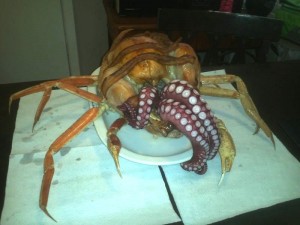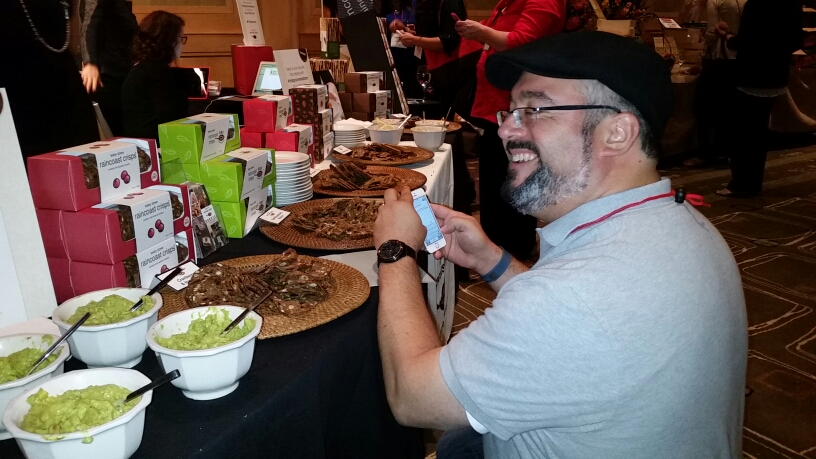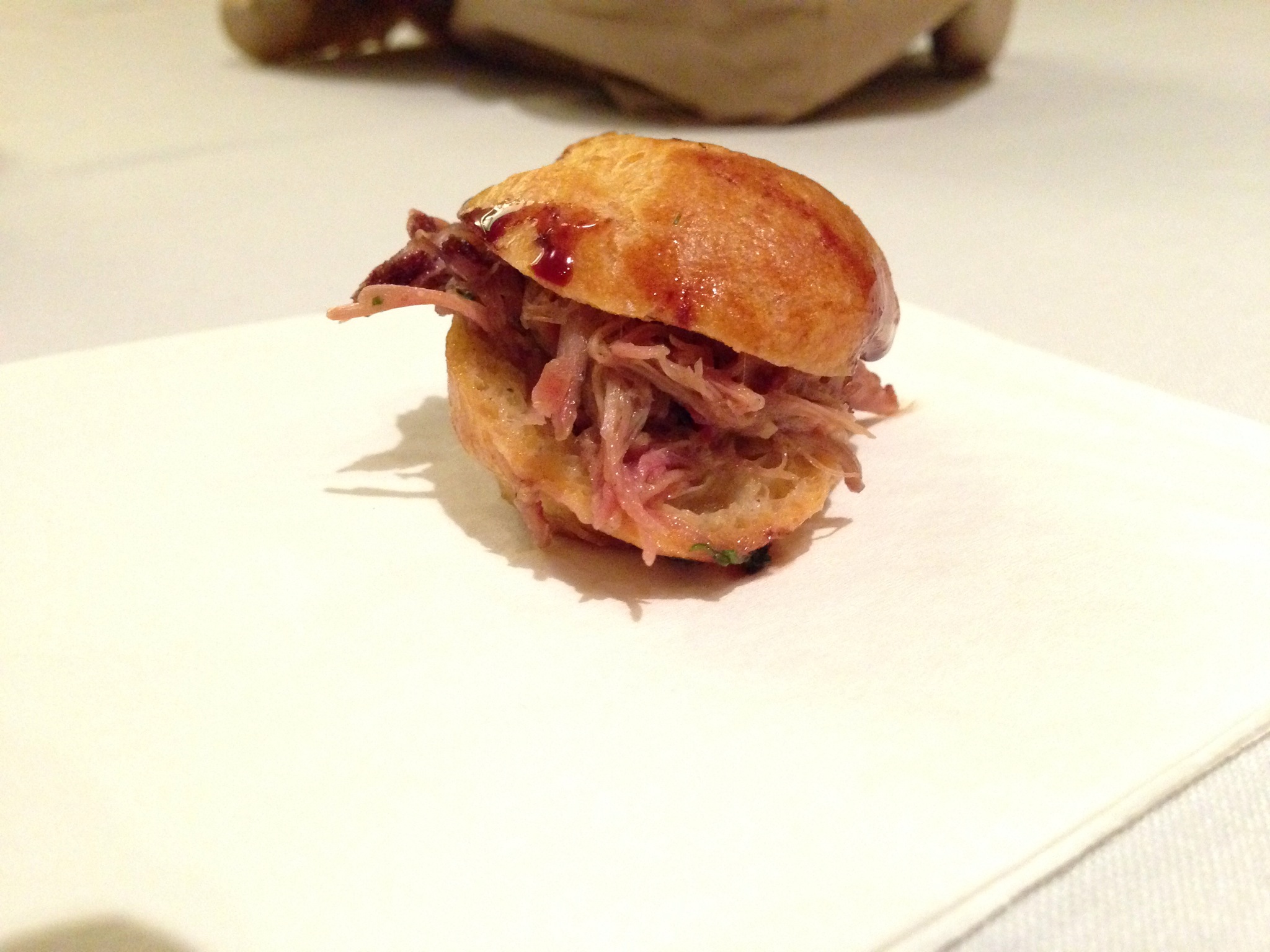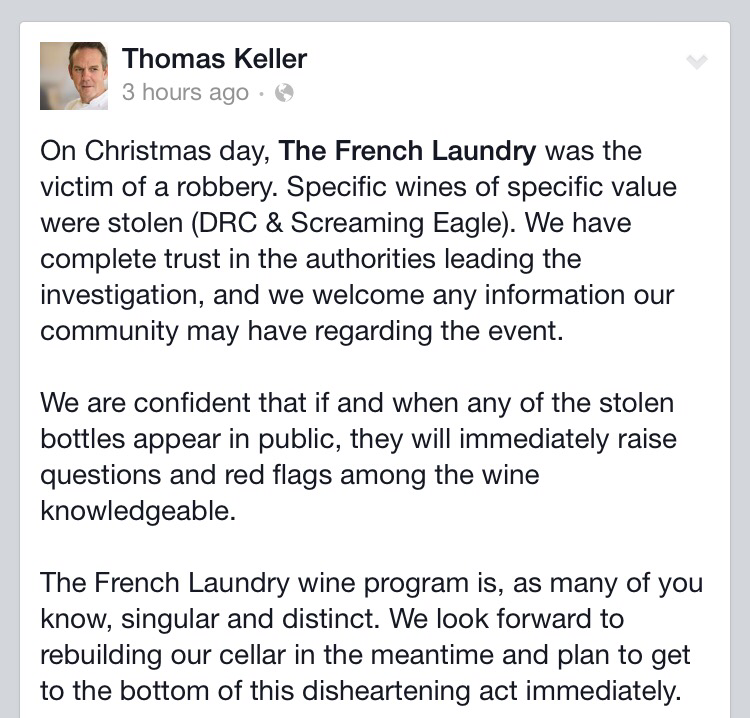Star chef David Chang of Momofuku posted this gem to Facebook late last night, and I couldn’t resist sharing. His caption, “My cook thought he spelled it right.”
Rare wines stolen from The French Laundry
Famed Napa Valley restaurant The French Laundry in Yountville is the apparent victim of a wine heist. Chef-owner Thomas Keller announced what happened on Facebook:
The thieves clearly knew what they were picking from the restaurant’s esteemed wine cellar. DRC and Screaming Eagle each are among the world’s most highly prized wines. Each sells for over $3,000 per bottle at Keller’s flagship restaurant.
Enter Entrepreneur Barbie

Uproar over a misogynistic Barbie childrens book that portrayed girls as inept at writing software or even operating a desktop computer overshadowed the recent introduction of Entrepreneur Barbie, who is “ready for the next big pitch” right out of the box, according to manufacturer Mattel on its website.
“Barbie Entrepreneur doll wears a sophisticated dress in signature pink that features modern color blocking and a sleek silhouette. Luxe details, like a glam necklace, cool clutch and elegant hairstyle, are smart, professional touches,” says Mattel. “Her “smartphone,” tablet and briefcase are the tools of her trade and always by her side!”
Adds UnMarketing, the doll “now comes with gut-wrenching self-doubt and receivables collection issues!”
#GoodRiddanceDay: Start 2015 with a clean slate
Here’s a fun idea from Times Square Alliance that is also good for the environment and probably your mental health, too, as a way of starting 2015 with a clean slate. Good Riddance Day is a designated time to close the chapter on 2014 so that 2015 starts fresh. Everyone has thoughts or issues they want to leave behind, right?
The official event is Sunday, December 28 at noon in Times Square in New York City, but you can mark the occasion from anywhere. From the business group’s website:
Have a picture of a significant other who’s proven less significant, a mortgage document that’s now history, or a medical bill that signifies a triumphant defeat? Shred-it and forget it!
Good Riddance Day is inspired by a Latin American tradition in which New Year’s revelers stuffed dolls with objects representing bad memories before setting them on fire. There will be no bonfire in Times Square, but we invite you to shed and shred your forgettable memories from 2014 for a fresh start in 2015.
Can’t make it to Times Square? Submit your unwanted memories here or tweet at @TimesSquareNYC using #GoodRiddanceDay and we’ll help you forget it by shredding it.
Cleverly sponsored by a shredding company, this seems like a tradition worth adopting.
Life-long vegetarian tastes barbecue
Cthurkey? Stuff this turkey with crab, octopus and bacon
Not sure whether this sounds delicious, or horrifying, or both. According to Gothamist.com, a database engineer in Texas created this thing he calls a Cthurkey (a nod to horror writer H. P. Lovecraft’s octopus-head creature the “Cthulhu“) made from turkey, octopus, crab legs and bacon. His recipe calls for cooking each part separately, so it’s more of a presentation than an actual dish. Read more at Gothamist.com, which published this first in 2013.

Spatchcock: It’s not just for chickens anymore

Half the fun of cooking poultry using the “spatchcock” method is being able to say that funny word. But it’s also a truly awesome method to cook chickens, and, as Mark Bittman has advocated since 2002, can be used to cut turkey roasting time from several hours to less than one. That can transform Thanksgiving as we know it.
Spatchcocking is simply a technique in which a chicken or turkey is butterflied by removing the back bone, so it can lay flat on a grill or roasting pan. Eliminating the bird’s cavity eliminates the biggest challenge when roasting a turkey or chicken, because it enables the heat to be more carefully controlled and not wasted on the vacant space. (Stuffing a turkey reduces the variability, too, but extends cooking time and also creates some food safety issues if the temperature isn’t monitored carefully.)
Here are a couple of resources to learn about spatchcocking turkey and how to do it:
- How to Cook a Spatchcocked Turkey on Serious Eats, includes a good video demonstration.
- Mark Bittman’s original 2002 recipe or his 2008 video, that makes it super clear how to do and how easy it is.
- An excellent article on Quartz.com: The story of spatchcocking and how Mark Bittman changed Thanksgiving forever.
From the Quartz.com article comes this interesting graph from Google, showing the frequency of searches for the term “spatchcock” over time:
Ebola Outbreak: Expert Answers to Common Questions
The Science of Ebola
Ebola has been studied since the mid-1970s, when the first cases near the Ebola River in Africa were identified. This summary is based on a review of some of the major studies and briefings by some of the world’s top experts as part of my role at work.
People in the United States can protect themselves by spreading facts, not fear. There’s plenty still unknown, but we know way more than a lot of people think. For example, there’s been a lot of lab research to determine whether Ebola can be transmitted in the air or other casual contact. None of the studies indicate that it can be.
Here are some things we know about the Ebola virus, which scientists have been studying since the 1970s:
- A person infected with Ebola is not contagious until after symptoms appear. In fact, the virus frequently is undetectable in the blood of an infected person – even with the most precise tests available – until after symptoms appear. This is why the risk to other people is extremely low until the infection begins to trigger symptoms.
- There is no evidence at all to suggest that casual contact transmits Ebola. Many health care workers and others have safely been in rooms or other close quarters with Ebola patients. In Dallas, four people were in the apartment with Thomas Eric Duncan when he was very sick with Ebola and all have been free of infection, more than 21 days later. All 43 people who were near Mr. Duncan but not involved in his hospital care are confirmed to be free of infection.
- The virus replicates extremely rapidly once symptoms begin, which is why the protocol for health care workers who have left an outbreak area calls for twice daily temperature checks. This is a known way to identify possible Ebola infection at the earliest point.
- While the Ebola virus replicates quickly in a person who has symptoms of Ebola Virus Disease, the virus does not have much strength once outside an infected person. If a droplet lands on a surface like a doorknob or countertop, the virus survives only a few hours and is easily killed by ordinary household cleaners (bleach is recommended.)
- There has been no evidence that Ebola is transmitted through the air, nor have lab studies indicated this happens.
- In order for the disease to spread, a droplet of body fluid must be transferred directly from a symptomatic person to an entry point in another person within about three feet — through a cut or other break in the skin, eyes, nose, mouth, or other opening.
- Body fluids include – quoting the CDC here – “pee, poop, spit, sweat, vomit, semen, or breast milk” or blood. The virus does survive in blood longer than in other fluids.
- Transmission via sweat is a theoretical possibility but remote — and relatively far-fetched outside of the rural parts of Africa where the facilities are so poor. It would require sweat from a symptomatic patient to be transferred directly onto another person and enter their system through eyes, mouth, a cut or other opening. The viral load in sweat is low until patients are violently sick. There was one documented case in 2001 in Uganda involving a person who contracted the disease after sleeping on a blanket that had been used by another person who died of Ebola. No other cases like this have been reported, and most cases where contact with sweat was suspected involved people who also had other exposure, such as to an Ebola patient’s blood.
- One of the reasons the CDC recommends isolation and confirmatory tests as soon as fever first occurs in a person who was in the outbreak area is that the viral load grows logarithmically after the first couple of days from symptom onset – 3 days seems to be typical. In New York, an Ebola blood test takes a few hours. That’s different from most other places where test results can take overnight, days or even longer. A test before symptoms wouldn’t find the virus, but a test at the earliest onset of symptoms probably would — and increases the chances of successful treatment. This is what happened in the case of Dr. Craig Spencer, who was isolated as soon as his temperature went above normal (to 100.3 degrees.)
If you are concerned about Ebola in the United States, get a flu shot. This will help both because the flu sickens and kills many more people than Ebola and because flu symptoms may be mistaken for Ebola symptoms in people who misunderstand their risks. If you have a flu shot and exhibit fever, nausea, or other possible signs of Ebola, doctors will have an easier time figuring out what your illness actually is. Mayor DiBlasio said that preventing the flu in New York is important so that the city’s emergency departments are not flooded with people who think they have Ebola but have no actual risk of getting it.
For more information, visit the NYC Department of Health website at http://www.nyc.gov/html/doh/html/diseases/ebola.shtml or the U.S. Centers for Disease Control and Prevention website at http://www.cdc.gov/vhf/ebola/index.html.
The source for most of this article is http://www.cdc.gov/vhf/ebola/transmission/human-transmission.html and the studies that are cited on that page. This article is not intended as medical advice. For that, please consult your own health care professional.
A weekend of discovery at food blogger conference

This weekend is the International Food Bloggers Conference in Seattle. It’s hard to think of a more food-obsessed city, so this will be a weekend of discovery. New commercial products, inventive chef creations, and a chance to explore the food scene of the Northwest. Here are a couple of images from the first few hours.
In addition to tasting plenty of interesting food (it’s ok for you to be jealous,) there’s real work here, and real learning. One excellent session earlier today focused on food photography, specifically how to break out of the cliche pictures that so many of us take.
One of Seattle’s top chefs, Thierry Rautureau (thechefinthehat.com) of Loulay restaurant, demonstrated how to make a simple fresh tomato soup with just a few ingredients pureed in a blender. He suggests freezing the puree in bags, then defrost and puree again with olive oil right before serving.
An emerging theme of the conference is the promotion of vegetables to center stage instead of side dish. Food writer Karen Page told the bloggers that people around the world – and especially in industrialized countries like the United States – are catching on to the idea that vegetables hold the flavors that makes dishes exciting. Chef Thierry favors brining vegetables to add spice to Thanksgiving dinner, or lightly pickling celery sticks to make the crunchy bites a bit more interesting.
Advice from the French chef: Don’t freeze squash. “Zucchini is great vegetable to shred and put it right on a grill, but if you freeze it, you have a mushy blah thing,” says Rautureau.






